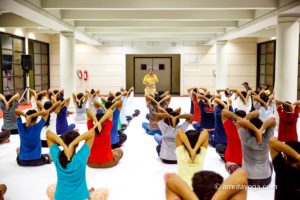 Does “Slow Revolution” Yoga have a place in our fast-paced world?
Does “Slow Revolution” Yoga have a place in our fast-paced world?
In the Yoga world of vigorous asana classes, there has recently been a renewed interest in Slow Yoga. In Vinyasa, it is called “Slow Flow.” Rodney Yee (a well known yoga teacher) calls his class, “Slow Burn”. This is advertised as yoga for a “sculpted physique and greater mental focus”. This “Slow Flow” style is not so new and has been the traditional method of yoga asana practice for centuries. It was predominant before the vigorous yoga form initiated by Pattabhi Jois that has dominated Yoga in the west.
 (Pattabhi Jois was a well known yoga teacher from south India. He helped popularize Mysore Style of Ashtanga yoga.)
(Pattabhi Jois was a well known yoga teacher from south India. He helped popularize Mysore Style of Ashtanga yoga.)
It’s interesting to see this resurgence of “old school yoga” in this fast paced world. Perhaps people are tiring of the fast and intense approach of forms like Vinyasa, or Bikram. Perhaps we are realizing how ultimately unsustainable the fast pace is.
(“Bikram” is a vigorous style of yoga done in heated rooms with a set sequence.)
 The philosophy of sustainability is influencing everything from the environmental movement, the slow food movement, and now the yoga movement. We are becoming aware that the fast paced world is a fast track to serious health problems in the macrocosm of our planet and the microcosm of our bodies.
The philosophy of sustainability is influencing everything from the environmental movement, the slow food movement, and now the yoga movement. We are becoming aware that the fast paced world is a fast track to serious health problems in the macrocosm of our planet and the microcosm of our bodies.
The rat race is a disappointment for many of us. Due to a promised reward in the future, we’re now victims of burn out, rushing to achieve some kind of abstract goal. We’ve missed the happiness only found in the present moment.
 Slowing down is one way to take a needed break and ask ourselves the purpose of this mad race. It enables us to ponder the question: why are we doing asana practice? Are we doing asana practice because we want that “sculpted physique”? Do we want to be stronger and more flexible? Or do we want to find relief from pain or induce relaxation? Slowing down our asana practice allows us to step back from trying to accomplish something. It gives us the space and time to inquire and experience our own true purpose for doing yoga.
Slowing down is one way to take a needed break and ask ourselves the purpose of this mad race. It enables us to ponder the question: why are we doing asana practice? Are we doing asana practice because we want that “sculpted physique”? Do we want to be stronger and more flexible? Or do we want to find relief from pain or induce relaxation? Slowing down our asana practice allows us to step back from trying to accomplish something. It gives us the space and time to inquire and experience our own true purpose for doing yoga.
The traditional form of asana practice has always been slow and meditative. Yoga was never meant to be a sport like gymnastics. In fact, it is quite the opposite. A big difference is how the muscles are used. In most sports the muscles are contracted to initiate movement. In asana practice, the emphasis is on stretching the muscles. In sports, the breathing is quick and shallow. In yoga, the breathing is slow, deep and full. Asana practice induces a state of relaxation by conserving energy (prana) in the body while energizing it with fresh oxygen. This brings prana to the whole system.
 Only by controlling and slowing down the movements while breathing fully—inhaling and exhaling fully—can we induce this state of energized relaxation. Moving quickly and without mindfulness creates a drain of energy. This is the opposite of what yoga aims to achieve. Unfortunately, this is what happens when we practice vigorous and tense yoga without attention on the breath!
Only by controlling and slowing down the movements while breathing fully—inhaling and exhaling fully—can we induce this state of energized relaxation. Moving quickly and without mindfulness creates a drain of energy. This is the opposite of what yoga aims to achieve. Unfortunately, this is what happens when we practice vigorous and tense yoga without attention on the breath!
In Amrita Yoga, sequences are first done in a controlled manner, coordinated with the breath and mantra. Then the asana pose is held for some time while breathing with awareness. This allows the muscles to stretch fully and also accentuates the deeper benefits of the asana on particular organs, on the subtle sheaths and the subtle mind. This way of practicing creates a state where we explore deeper states of being that take us beyond the surface of this fast paced world.
Many great sages have said that the body is a great vehicle for Self Realization. In Amrita Yoga, asana practice is done not to push and injure the body but to revere it. The body is the vehicle to realize we are not the body! Many yoga practitioners who have come to Amritapuri and taken an Amrita Yoga sadhana retreat have been profoundly touched to their core by this unique way of doing asana.
 They have often remarked on how completely different it is to any form they have experienced. When they first encounter an Amrita Yoga class, they approach it with the competitive, fast-paced form they had learned from their previous yoga teaching method or studio experience. They quickly realize that Amrita Yoga has a very different approach and subsequently adjust themselves accordingly. They move more mindfully and breathe in a gentle harmony that comes from a deeper place within. Many are moved to tears by the experience and return every year to imbibe this new form. Dipping their souls into this beautiful colour, like dipping a cloth into dye again and again until every cell, the very fiber of their being is transformed!
They have often remarked on how completely different it is to any form they have experienced. When they first encounter an Amrita Yoga class, they approach it with the competitive, fast-paced form they had learned from their previous yoga teaching method or studio experience. They quickly realize that Amrita Yoga has a very different approach and subsequently adjust themselves accordingly. They move more mindfully and breathe in a gentle harmony that comes from a deeper place within. Many are moved to tears by the experience and return every year to imbibe this new form. Dipping their souls into this beautiful colour, like dipping a cloth into dye again and again until every cell, the very fiber of their being is transformed!
This is the slow and gentle path to transformation—the “slow revolution”. This brings practitioners to an inner peace and joy that extends from the yoga mat, transforming lives from within to help us navigate this fast-paced world.
By Rosario Kerekes
As always, thoughtful comments are invited and appreciated. Share your reflections with us! See below to leave a comment.

0 Comments